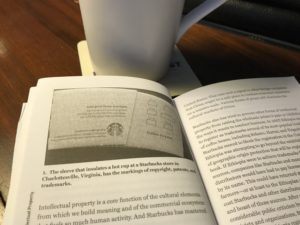Intellectual property is the culmination of brain work: ideas made manifest are legally defined and protected to variously advance the interests of their creators and the public good. Intellectual property is also arguably the most important and least clearly understood concept in the world most Scholarly Kitchen readers live and work in.

Siva Vaidhyanathan is a professor of Media Studies at the University of Virginia, and the author of books including Copyrights and Copywrongs: The Rise of Intellectual Property and The Googlization of Everything (and Why We Should Worry). Amazon helpfully reminded me that I bought the latter just shortly after it was published in 2011, thereby underscoring one of its broader points. Googlization wasn’t about, as one review asked, whether Google “turned evil,” but about the impact of information aggregation and dissemination organized by algorithms designed for market rather than knowledge development. Awareness about the business models driving services we have welcomed into our daily practices has been a key part of recent discussions in scholarly communications, though I sometimes wonder whether we have fully digested the import of this insight or if it’s still a lump in the middle of the python. Debates about the character of search engines, analysis of scholarly research through citation and other metrics, and for-profit networks such as Academia.edu are all part of a growing comprehension that the structures around us were not built for the uses to which we put them; we search for information online, and as we do so those search engines are compiling a lot more information about us.
Vaidhyanathan has now written a book with the premise that understanding the basics, and by extension, some of the subtleties involved in how intellectual property law and practice has evolved, really matters. It’s clearly part of his larger interest in revealing, if not as dramatically as Neo taking the red pill to reveal The Matrix, the structures to which we’ve become so accustomed and the contours of which are now so indistinct that even resistance to them can be misdirected. Vaidhyanathan has chosen to (or rather, was encouraged by an editor) write this in a slightly unusual format, the Oxford University Press Very Short Introductions (VSI) series. Launched in 1995, the series of now over 500 titles offers “concise and original” treatment of a vast array of topics. I like the concept of the VSI series, though I also find it a bit intellectually oxymoronic. No one wants (or maybe OUP thinks no one can market) a Very Short Introduction to a topic that isn’t already understood to be so significant as to make this brevity appealing. In other words, to want a Very Short Introduction, you have to already understand the subject, at least a little. I can think of subjects that could use a Very Short Introduction, but might not be so recognizable and summarize-able as to warrant commissioning one. Just looking at the alphabetical list of VSIs is interesting; three titles in the BLs are Black Holes, Blood, and The Blues. New and forthcoming titles include Big Data and Perception while Consciousness and Dinosaurs are about to be released in second editions. If it’s tempting to read the VSI title list as a reflection of the educated reader zeitgeist, Vaidhyanathan’s Intellectual Property certainly seems to fit our moment.
 I have no doubt that Black Holes, Blood, and The Blues are complex subjects, difficult to convey within the confines of the VSI template. I’m going to go out on a limb, saw in hand, and suggest that intellectual property offers particular authorial challenges; to explicate the concept and demonstrate its present valence one has to grapple with at least three distinctive disciplinary traditions — humanities, law, and science (and/ or engineering) — as well as narrative conventions. Vaidhyanathan takes up this challenge at a fairly brisk pace. The first chapter, “How to Read Starbucks, or why intellectual property matters more than you think,” offers as a case study an image of a Starbucks coffee sleeve marked with copyright, patent, and trademark claims to introduce the complexity of distinct yet overlapping domains of intellectual property protection. “Intellectual property,” he points out, “stands in for a complex tangle of laws, policies, and values that govern the dissemination of ideas, expressions, inventions, creativity, and data collection.” (p. 10) At their best, copyright and patent law encourage respectively creative work and invention, while trademarks underscore a product’s distinctive identity or origin. If “copyrights are for poems; patents are for mousetraps” and computer software is covered by both. In the United States, intellectual property law has its origins in the British common law tradition, but the globalization of intellectual property challenges its market-based orientation.
I have no doubt that Black Holes, Blood, and The Blues are complex subjects, difficult to convey within the confines of the VSI template. I’m going to go out on a limb, saw in hand, and suggest that intellectual property offers particular authorial challenges; to explicate the concept and demonstrate its present valence one has to grapple with at least three distinctive disciplinary traditions — humanities, law, and science (and/ or engineering) — as well as narrative conventions. Vaidhyanathan takes up this challenge at a fairly brisk pace. The first chapter, “How to Read Starbucks, or why intellectual property matters more than you think,” offers as a case study an image of a Starbucks coffee sleeve marked with copyright, patent, and trademark claims to introduce the complexity of distinct yet overlapping domains of intellectual property protection. “Intellectual property,” he points out, “stands in for a complex tangle of laws, policies, and values that govern the dissemination of ideas, expressions, inventions, creativity, and data collection.” (p. 10) At their best, copyright and patent law encourage respectively creative work and invention, while trademarks underscore a product’s distinctive identity or origin. If “copyrights are for poems; patents are for mousetraps” and computer software is covered by both. In the United States, intellectual property law has its origins in the British common law tradition, but the globalization of intellectual property challenges its market-based orientation.
In four chapters, Vaidhyanathan explores copyright, patents, trademarks, and other forms of rights such as domain names and publicity in more detail. The illustrations, most of them photographs taken by Vaidhyanathan, are wonderfully indicative. They include images of a used bookstore (copyright holders control the first sale of a work, not resale), a display of Italian cheeses (protected geographic indicators, eg “Parmigiano” vs parmesan), and a woman riding the subway wearing leggings decorated with the face of actor Ryan Gosling (celebrity right of publicity, like many other rights, is often hard to enforce). Copyright is “the most pervasive cultural regulatory system in the world” in which merely by our existence “most of us are deeply implicated.” The effects and the limits, most importantly “fair use” in the United State and “fair dealing” elsewhere, as well as the national and international dimensions of copyright as it has developed over the twentieth and into the twenty-first century, are explored. But here as elsewhere Vaidhyanathan is attentive to the ways that the digital information revolution has intercepted all manner of previous arrangements. The 2013 Google books case forced the issue of how and when copyright holders, as opposed to a service provider, could decide to move their work into the public domain via digital copy. That decision for Google, and two other key decisions reliant on interpretations of digital fair use, Vaidhyanathan argues, changed important aspects of how copyright works. But did it? Every aspect of intellectual property he examines has a deep and significant history, and a snarled set of legal prescriptions. The courts may now approach copyright differently, but what he calls “entrenched cultural habits” of copyright, including more restrictive notions of fair use and, as in the case of France, a creator’s “moral rights” to determine the original and subsequent forms of their work, still often inhere outside technical debates in courtrooms.
Copyright is “the most pervasive cultural regulatory system in the world” in which merely by our existence “most of us are deeply implicated.”
Intellectual property restrictions were designed with the understanding that incentives to the individual to create or invent for the marketplace would provide public benefit. Whether you think that they do that effectively or not may depend entirely on which side of the incentive structure you happen to sit. But just as often, perhaps even most of the time, individuals are on both sides at once. Vaidhyanathan cites Garrett Hardin’s “tragedy of the commons” to illustrate the problem of shared and depleted resources. Without reasonable management, the ethic of sharing isn’t enough to protect the common good. The “tragedy of the anti-commons is one in which too many essential items are owned by individuals” so that costs are too high and benefits too concentrated. In both cases we presume that individuals should act for the common good, but are most likely to need incentives to do so. The larger problem is that the broader positions Vaidhyanathan identifies as aligned with “the commons” or “the anti-commons” are simply not stable even to the individual let alone broader communities. The elephant in the commons is the market itself. Should it, or must it, have a role in producing public benefit? Reasonable people disagree here too. And thus the nature of intellectual property, rooted in market incentives to the individual but imagined as (eventual) public good run up against demands for more obvious and immediate public benefit. Here is where “Access to Knowledge” movements, from LINUX to Wikipedia, take root in different soil. Those movements claim market agnosticism, though Vaidhyanathan seems to preach market moderation.

The omnipresence of Starbucks is an amusing and effective feature of this book. Sitting in different Starbucks locations, Vaidhyantahan comments on the significance of intellectual property as a way for the company to shape their products and protect their place in the market well beyond the coffee sleeve. And by the covers in which it sits, this commentary on product branding invites all sorts of questions. The VSI series attempts a trademark look. The books are all 4 1/2″ by 6 3/4″, with multi-colored cover paintings by Martha Lewis, and run between 120 and 150 pages. If I published a short introduction to a topic, in a similar size and with a similar cover styling, could OUP claim infringement? Is my image of Vaidhyanathan’s page 4 with his image of the Starbucks sleeve fair use? Is it ambient, derivative or sufficiently transformative of the original?
In the course of a book tracing the legal paths by which ideas about intellectual property has traveled, Vaidhyanathan illuminates conflicting truths. “Intellectual Property exists as it does because powerful interests want it to exist” and yet because “intellectual property is fundamentally political” it can be challenged on (formal or informal) political grounds. (p. 97) Vaidhyanathan thus concludes where I think he means to begin, which is by exhorting us to pay ever closer attention to the key infrastructures of the knowledge economy “to [better] forge the intellectual property systems we deserve.” In this smart, engaging book, surprisingly provocative for a short introduction, he won this reader.
Discussion
6 Thoughts on "Intellectual Property, Long Story Short"
There is no question that fair-use jurisprudence has been given new life and new direction by a series of court cases that followed the publication of Judge Pierre Leval’s now cklassic article “Toward a Theory of Fair Use” in the Harvard Law Review in 1990. His idea of “transformative use” played a key role in the Supreme Court decision in 1994 Campbell v. Acuff-Rose (about the 2 Live Crew parody of Johnny Cash’s “Pretty Woman”), then influenced a series of decisions in the Ninth Circuit starting with Kelly v. Arriba-Soft (2003) and Perfect 10 v. Google (2007), was crucial in the case in Authors Guild V. HathiTrust (2014), and then in Authors Guild v. Google (2016) where Judge Leval himself rendered the opinion.
Not sure on what ground OUP could claim infringement for another publishers just using the same format as this series does. No copyright, trademark, patent, or trade secret right at issue here, as far as I can see.
The fact that 2 Live Crew ended up being so influential in IP-related legal cases amuses me to no end!
Now about Karin’s hypothetical regarding infringement/fair use of OUP’s IP by posting a photo of the book in question… and let’s say there is a case to be made… who’d be held liable in the first place — Karin for using it in her post, or rather SK/SSP for actually publishing it?
Given that the Executive Editor of this site is an employee of OUP, I can offer my assurances that the image is used with permission.
But as usual, the way fair use works is that you can’t tell if something is fair use until someone sues you for it and a court officially proclaims it to be (or not be) fair use. Here if one weighs the four factors in making such determinations (http://fairuse.stanford.edu/overview/fair-use/four-factors/) I would suggest that this is a pretty cut and dried case of fair use.
Would a case be raised, our bloggers are covered by SSP’s insurance against such claims, dating back to the lawsuit that was threatened against us because of a post:
https://scholarlykitchen.sspnet.org/2013/03/29/posts-removed-because-weve-received-letters-from-edwin-mellen-press-attorney/
and
https://scholarlykitchen.sspnet.org/2013/04/03/ssp-board-decides-to-reinstate-removed-posts/
Yeah I figured as much… Did Karin seek formal permission from OUP, or did you get that sorted on your own accord?
Neither really. The original draft of the post didn’t include the book cover image (just Karin’s original photograph of the book (which being an original work, seems an even stronger fair use case). I added the book cover image knowing our policies and that use in a review is not something we’d take offense to (or have much legal standing to contest).
It’s nice to get a reminder that intellectual property is fundamentally political; so many people seem to start off with an assumption that IP rights are Lockean natural rights.
Certainly the unified trade dress of the Very Short Introductions series would be protected by the Lanham Act (as would the phrase “Very Short Introduction”) whether formally registered or not even though the concept of basic introductory books on various topics would not be. Several other publishers have broadly similar series with different series names and their own unified trade dress—e.g., NYU Press’s Keywords, U of Chicago Press’s Short Guides, and Icon Books’ Introducing . . . series—none of which could be confused for OUP’s series.


